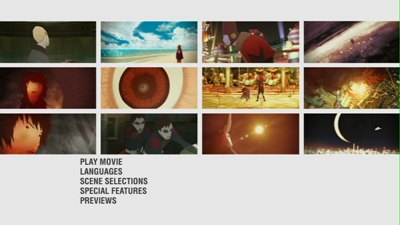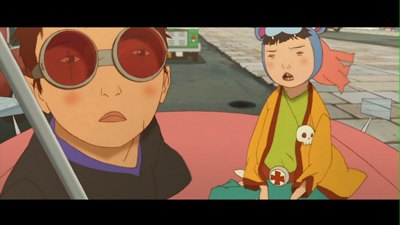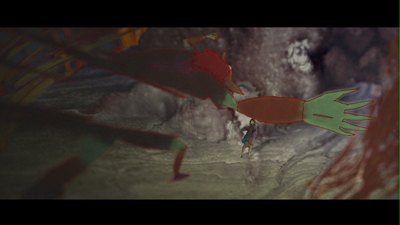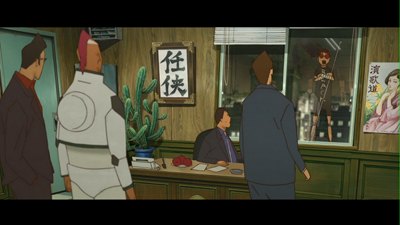| Reviews & Columns |
|
Reviews DVD TV on DVD Blu-ray 4K UHD International DVDs In Theaters Reviews by Studio Video Games Features Collector Series DVDs Easter Egg Database Interviews DVD Talk Radio Feature Articles Columns Anime Talk DVD Savant Horror DVDs The M.O.D. Squad Art House HD Talk Silent DVD
|
DVD Talk Forum |
|
|
| Resources |
|
DVD Price Search Customer Service #'s RCE Info Links |
|
Columns
|
|
|
Tekkon Kinkreet
THE MOVIE:

Anime is one of those things that people often have very broad, blanket opinions about. Even its fans likely have a certain image in their head, a definition for what the term means, that ends up being limited to what they like and not really an accurate encompassing of what Japanese animation is capable of. Even classifying anime as a genre is kind of wrong, not unless the animation from every other country is a genre unto itself, as well.
So let's dispense with that for Tekkonkinkreet (or Tekkon Kinkreet, depending on what you're looking at). Yes, it is a Japanese animated film, but whatever you think that means, Tekkonkinkreet does not fit. It's not that limited. It's a good film, pure and simple, with no other qualifiers needed. Even how it was made busts convention, being the first full-length animated film to be made in Japan with an American director, Michael Arias, and screenwriter, Anthony Weintraub, both of whom had done work on The Animatrix. (And for those wondering, "Tekkonkinkreet" is a play on words with no literal translation. It refers to "a concrete structure with an iron frame," and is used here to suggest images of hard reality versus malleable imagination.)
Based on the cult-hit manga by Blue Spring-creator Taiyo Matsumoto (previously released in English as Black & White), Tekkonkinkreet is a surreal warping of genre. One of my DVDTalk colleagues, David Walker, has compared it to Mean Streets, and I think that's a very smart starting point. Set in Treasure Town, Tekkonkinkreet is the story of three generations of hoodlums that roam in its shadows. Though Treasure Town has an almost Third-World futuristic look to it in the way things stack up on each other and advertising is crammed into every corner, it is in reality a nostalgic remodel on Japanese seaside towns, colored first by Matsumoto's memory and second by the imaginative powers of childhood.

The central characters of Tekkonkinkreet, and the children whose perceptions provide Treasure Town with its unique scope, are the brothers Black and White, collectively known as the Cats, a two-man gang who rule Treasure Town. These orphans have learned how to get by all on their own, and thus their city has bent to their will. Children see everything as magical and nothing as impossible. Thus, Treasure Town is full of bright colors and wondrous sights, where pop culture and advertising is just fuel for a fertile mind, and two kids wearing goggles and funny hats can leap from building to building, surf traffic, and be the boss of their own world. Time is stopped in Treasure Town. It's a city in a bottle.
That's all changing, however, when the city's most famous gangster, Suzuki, a.k.a. the Rat, returns to Treasure Town's criminal underworld. Older and wiser, and looking more haggard for his years away, he leaves business in the hands of his protégé Kimura. When Black gives Kimura a beatdown, however, the gunsall's forced vacation leaves the door open for the introduction of a foreign influence, the creepy albino-looking Mr. Snake and his scientifically bred thugs. Snake wants to obliterate everything that's old. He wants to tear down the city and rebuild it as a theme park, taking childhood memories and selling it back to the city as something else. If the crime thing ever stops working for Snake, he's got a great future as a Hollywood studio exec.
This reappropriation of childhood is one of the many themes at work in Tekkonkinkreet. The movie is largely about change, and the dangers that come with it, of moving forward at the expense of your own ideals. Rat, Kimura, and the Cats represent three levels of the criminal element, and it's fitting that it's the middle one who may ultimately betray everything. Likewise, Black faces his own in-between state. Surrendering White to the police under the mistaken belief that his younger brother will be better off being raised off the streets puts Black in a precarious position. Without his other half, he goes bonkers, unable to function. The final quarter of the film is made up of his journey across the dreamscape, confronting the urban legend that is believed to be the real ruler of Treasure Town, the Minotaur. Black could let go of White, let go of childhood, and embrace darkness and the adult world, but at what price?
There is a lot going on here about the bonds between men. We have the father and son relationship of Rat and Kimura, and, of course, the yin yang of the brothers Black and White. The pair naturally creates a sense of balance. Black is more practical, he is the provider, whereas White is the dreamer. He represents the love and truth that Rat tells Kimura are the keys to life, and that Kimura ends up searching for. At one point, the boys' grandfather says that Black thinks he protects White, but that White really protects Black. This is seen most vividly in the fight with one of Snake's enforcers. Black instinctively ducks to avoid a punch, but the wide swing then connects with the younger boy standing behind him. Yet, it ends up being White who carries Black away from that battle, and much later, it's only going to be White's love for him that keeps Black from going all the way to the dark side.
Tekkonkinkreet is an inspiring piece of cinema, one that gets better with each viewing. The first time around is like your discovery period, where you're likely to be overwhelmed by all the new data you are receiving. Once the shock of that is gone and you actually have a grasp of what the puzzle pieces are, the story reveals more and more layers and greater meaning. There is also so much visual information to drink in, you're going to want to revisit it just to see all of the wonderful pictures that Arias and his crew have created.
Fans of the Matsumoto comic book will be delighted to see the master's work in motion on screen. It's not an exact stylistic translation, but one that keeps the spirit of the original black-and-white drawings while adapting them to color animation. The backgrounds are super detailed, combining hand painting and digital work to give us something 3-D and realistic. By contrast, the characters are far more stylized, often looking like contour drawings, even reminding me of Jean Cocteau and Egon Schiele sketches. For all the bright colors, the animators also use a dingy, faded palette, with lots of various shades of brown that are evocative of an aging urban landscape. This gives them room to really let loose when they go into Black or White's visions, using what looks like crayon, color pencil, and even paint floating in water to give life to what are essentially a kid's scribblings. Tekkonkinkreet is gorgeous.
So, again, forget whatever preconception or prejudice you may have. Tekkonkinkreet is like nothing you have seen before, regardless of medium or country of origin. Prepare to have your mind fully blown.

THE DVD
Video:
All of that beautiful animation would be wasted if the DVD of Tekkonkinkreet were anything less than magnificent, and Sony has really gone all the way with their 2.35:1 anamorphic transfer. Having seen Tekkonkinkreet on the big screen at the Platform Animation Festival early this past summer, I can say that this DVD looks just as good as the print they showed at the screening.
Sound:
There are a wide variety of 5.1 audio tracks to choose from here, including dubs in English, Spanish, and Portuguese. The best, of course, is the original Japanese soundtrack, as it maintains the tone and intention of the production. The sound quality is marvelous, including a nice clarity for the excellent score done by avant-electronic musicians Plaid.
Since I speak neither Spanish nor Portuguese, I didn't sample those tracks, but I did take a listen to some of the scenes in English. Now, I've gotten mail in the past that has questioned why I am so prejudiced against dubs, and the basic germ for this distaste for re-recordings is that just because Tekkonkinkreet is a cartoon doesn't mean it should be given any less respect than a Kurosawa film. Would you watch The Seven Samurai with an American actor's voice substituted for Toshiro Mifune's?
Tekkonkinkreet's English version is a perfect example of why I don't like to hear American voices on top of my Japanese cartoons. The sound of the voices is all wrong. The cops are over-the-top and come off as caricatures, while instead of sounding like real kids, the U.S. versions of Black and White sound like child actors. In other words, canned and coached. The pitch is all wrong, with everyone several octaves higher than their Japanese counterparts and cranking up the energy level to get closer to your standard Saturday-morning ham.
In addition to the well-done English subtitles (I love that they subtitle the nonsense language Snake uses), there are Spanish, French, and Portuguese subtitles, and even an option for English subtitles on the audio commentary, despite being in English already. The extras are also subtitled in all languages except French. This is necessary as the extras were created for the Japanese DVD and are in Japanese.
Extras:
There are three rather good bonus features on the Tekkonkinkreet DVD.
Two of them are documentaries, "A Conversation with Director Michael Arias and British Music Duo Plaid" (11 minutes, 40 seconds) and "The Making of Tekkonkinkreet: Director Michael Arias' 300-Day Diary" (43 minutes). The Plaid feature is pretty self-explanatory, though I would have liked an option to hear the music isolated from the film. The second feature is an extensive look at the development of the motion picture, including the incredible planning that went into designing Treasure Town. Art director Shinji Kimura (Steamboy) talks at length about the map he made and shows his concept drawings. Other topics covered include Arias' move to Japan, the melding of traditional and digital animation, seeking out sound effects, the problems presented by certain special effects, deadline pressure, and the ultimate completion of the ever-evolving project. In addition to production art, you will also see animation in various stages of completion and breakdowns of complicated effects sequences.
The audio commentary on the movie features the three principle American crew members: Michael Arias, director; Anthony Weintraub, screenwriter; and Mitch Osias, sound designer (whose arrival in Japan we also see in the "300-Day Diary" featurette). It's a solid discussion, with the three old friends trading lots of information about how they did what they did. Very specific, very technical. They also talk about inspiration and sources for ideas, as well as how to adapt such a unique comic book, focusing it into a much more compact film.
The trailers section for Tekkonkinkreet has seven promos for films from Sony's anime/animation library (including the work of Katsuhiro Otomo and Satoshi Kon) and one commercial for their Blu-Ray line of H-D DVDs.
Though Tekkonkinkreet comes in a standard DVD case, it does have a full-color cardboard slipcover as well.
I should note that my promo version of the disc arrived with Viz Comics' fabulous new edition of the Taiyo Matsumoto manga. Retitled Tekkonkinkreet, this "All in One" edition is the first time the entire series has been released under one cover. Over six-hundred pages and printed at the over-sized proportions of a regular U.S. comic book (though slightly wider), the $30 cover price is a real steal. The manga is more complex and sprawling than the film, but then that's what one expects of a good novel as opposed to the movie version of it. The production on this new book is unbelievable. Not only is the artwork lovingly reproduced, but the overall look of the book is as jam-packed as a Matsumoto background. Though a paperback, the Tekkonkinkreet book has a full-color dust jacket with a second image printed on the inside. Likewise, the cover under the jacket has a different design, and the front of the book has a full-color pull-out painting of Black and White. Finally, to link this new release to the movie, the foreword to the manga is a conversation between Michael Arias and Anthony Weintraub. Seek this book out.
FINAL THOUGHTS:
The Japanese animated film Tekkonkinkreet is a gritty mix of life on the streets, sci-fi and gangsters, and vivid washes of surreal pop. This story of two brothers careens through themes of change, taking form in commercialization and gentrification, but also in aging, of passing from childhood into adulthood and the changing of the guard, old to new. It's about the bond of brotherhood and the war of the imagination in a world where creativity is constantly being co-opted for something that is hard and unbending. A visual delight, an exciting adventure, and a touching story about family, Tekkonkinkreet is more than the sum of its incredible parts. A decent handful of extras and high production values nudge this DVD into the upper reaches of Highly Recommended.

Jamie S. Rich is a novelist and comic book writer. He is best known for his collaborations with Joelle Jones, including the hardboiled crime comic book You Have Killed Me, the challenging romance 12 Reasons Why I Love Her, and the 2007 prose novel Have You Seen the Horizon Lately?, for which Jones did the cover. All three were published by Oni Press. His most recent projects include the futuristic romance A Boy and a Girl with Natalie Nourigat; Archer Coe and the Thousand Natural Shocks, a loopy crime tale drawn by Dan Christensen; and the horror miniseries Madame Frankenstein, a collaboration with Megan Levens. Follow Rich's blog at Confessions123.com.
|
| Popular Reviews |
| Sponsored Links |
|
|
| Sponsored Links |
|
|
| Release List | Reviews | Shop | Newsletter | Forum | DVD Giveaways | Blu-Ray | Advertise |
|
Copyright 2024 DVDTalk.com All Rights Reserved. Legal Info, Privacy Policy, Terms of Use,
Manage Preferences,
Your Privacy Choices | |||||||














